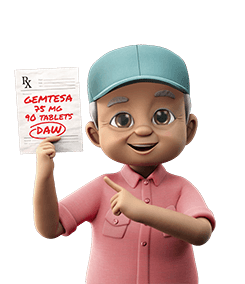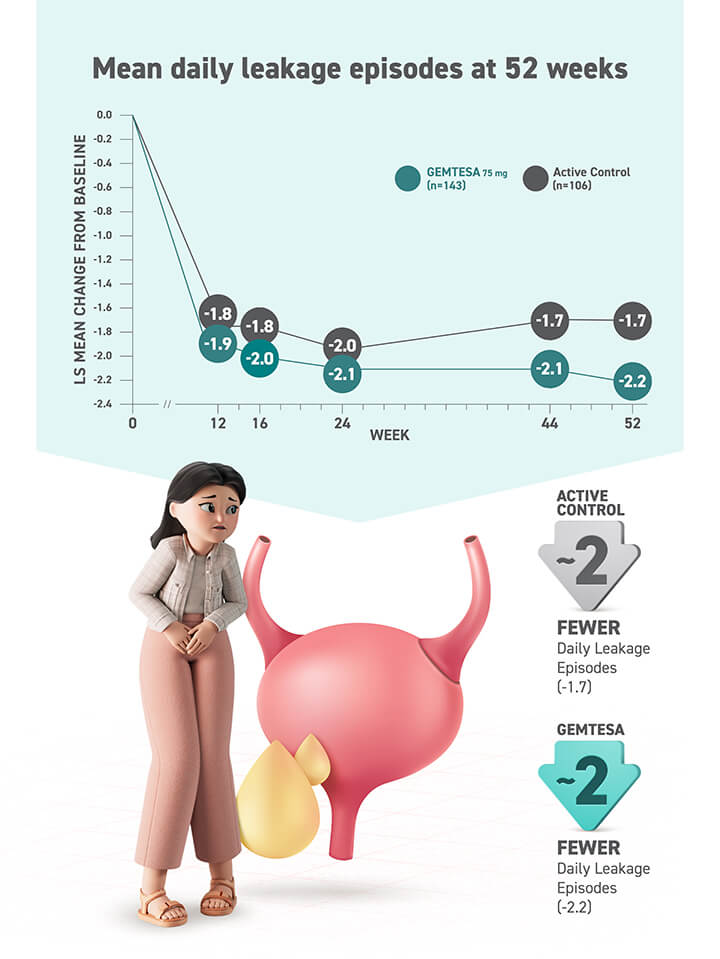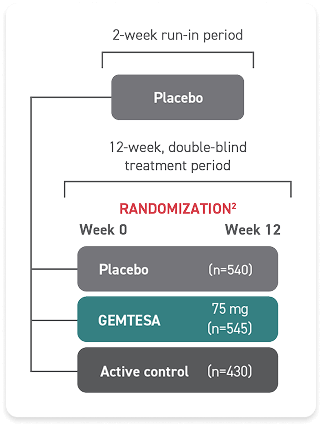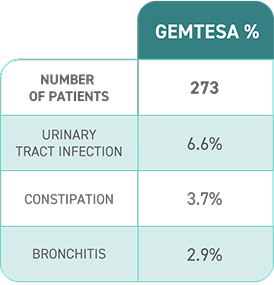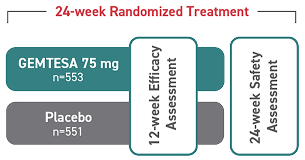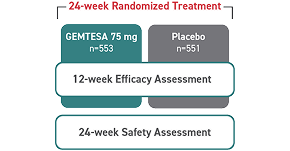Overactive bladder (OAB) is common for men. Talking about it isn’t.
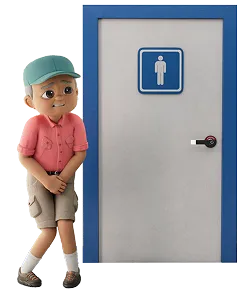
Many men often overlook their OAB symptoms of urgency, frequency, and leakage, hoping they will go away on their own. OAB symptoms may also be confused for the prostate-related symptoms of benign prostatic hyperplasia (BPH), a non-cancerous enlarged prostate.
However, OAB is a different chronic condition, and symptoms may worsen over time if not treated. While OAB cannot be cured, it can be managed.
Think you may have OAB? Here’s what to look for:
Normal bladder function means your brain triggers that “gotta-go” feeling when your bladder is full. With OAB, you feel you need to empty your bladder – even when it’s not full.
You should ask your doctor about OAB if you experience one or more of these symptoms:
Feeling a sudden urge to urinate right away (urgency)
Peeing more than 8 times a day (frequency)
Often having trouble “holding it” (urge urinary incontinence/leakage) or experiencing leaking before you can make it to the bathroom
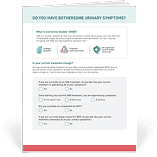
Print this tool and bring it to your next doctor's appointment to help start the discussion about your symptoms.
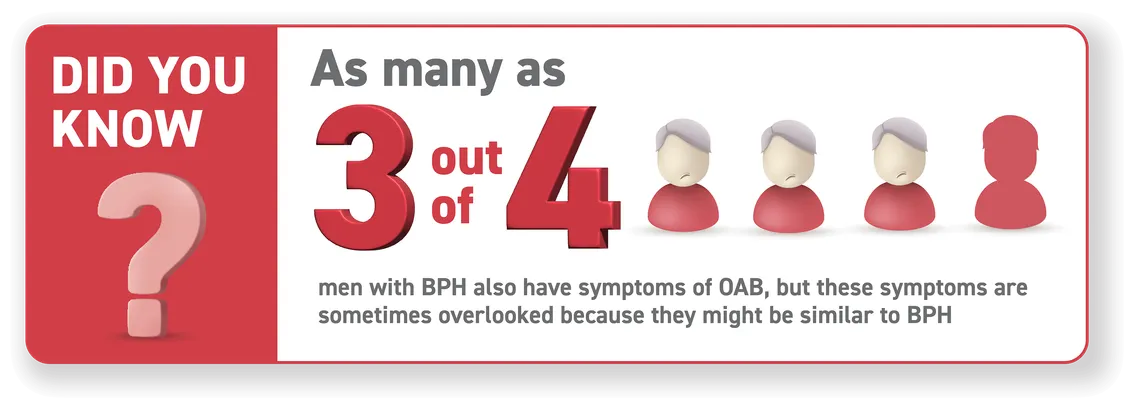
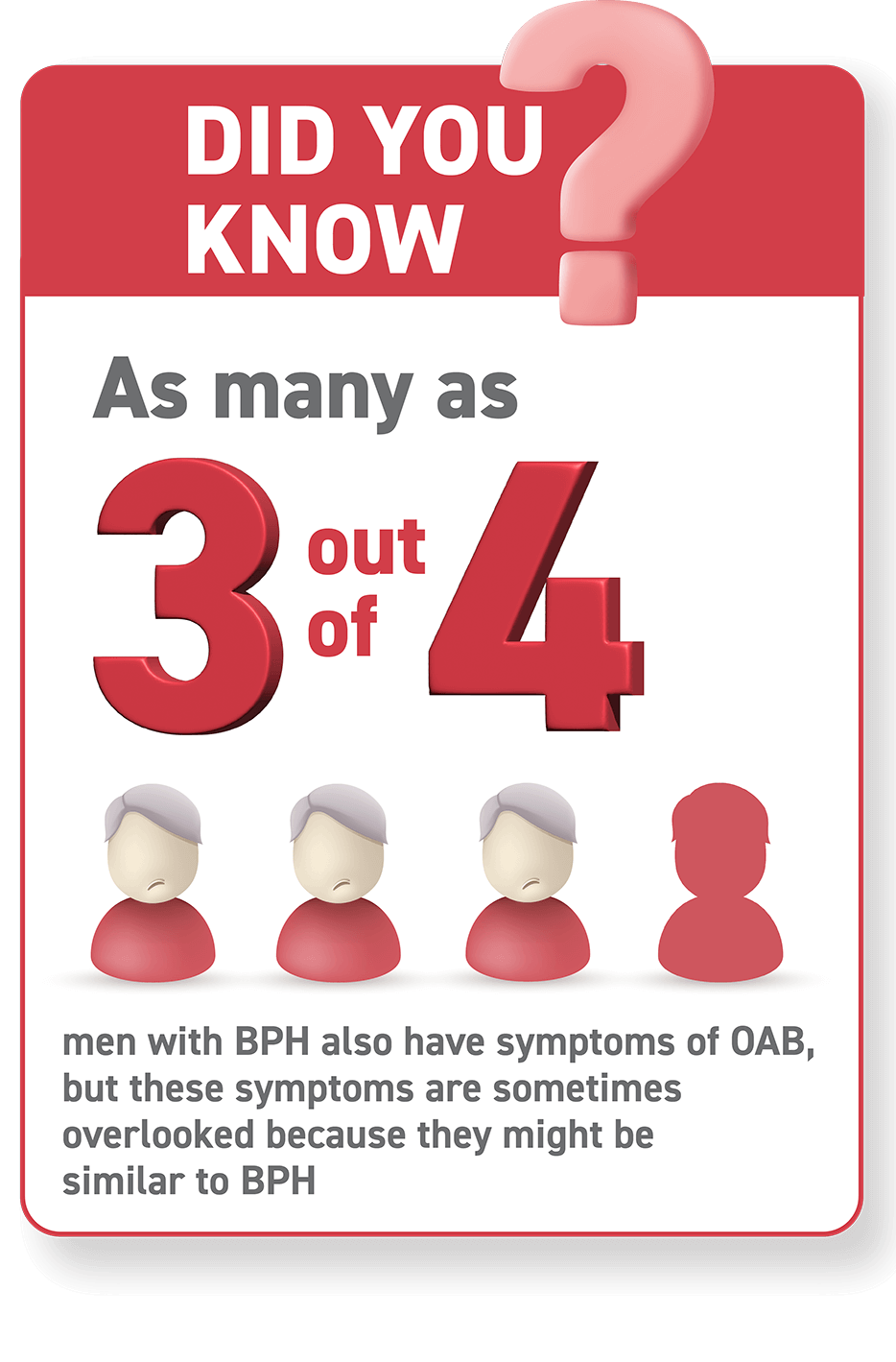
Know the difference between OAB and BPH
Because OAB and BPH have similar symptoms, the diagnosis of OAB may be overlooked. It’s important to ask your doctor to screen for both, as different medicines are used for each condition.
This is not a full list of all OAB or BPH symptoms. GEMTESA is indicated to treat the 3 key symptoms of OAB (leakage episodes, urgency, and frequency). OAB and BPH are different conditions and treated with different medicines.
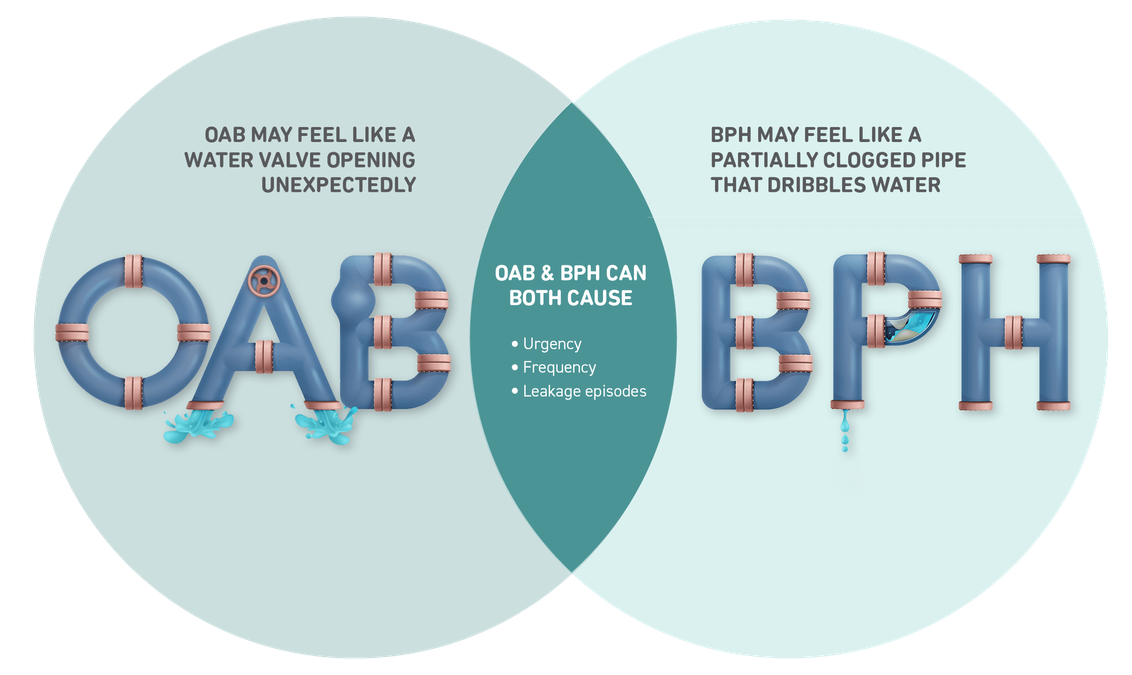
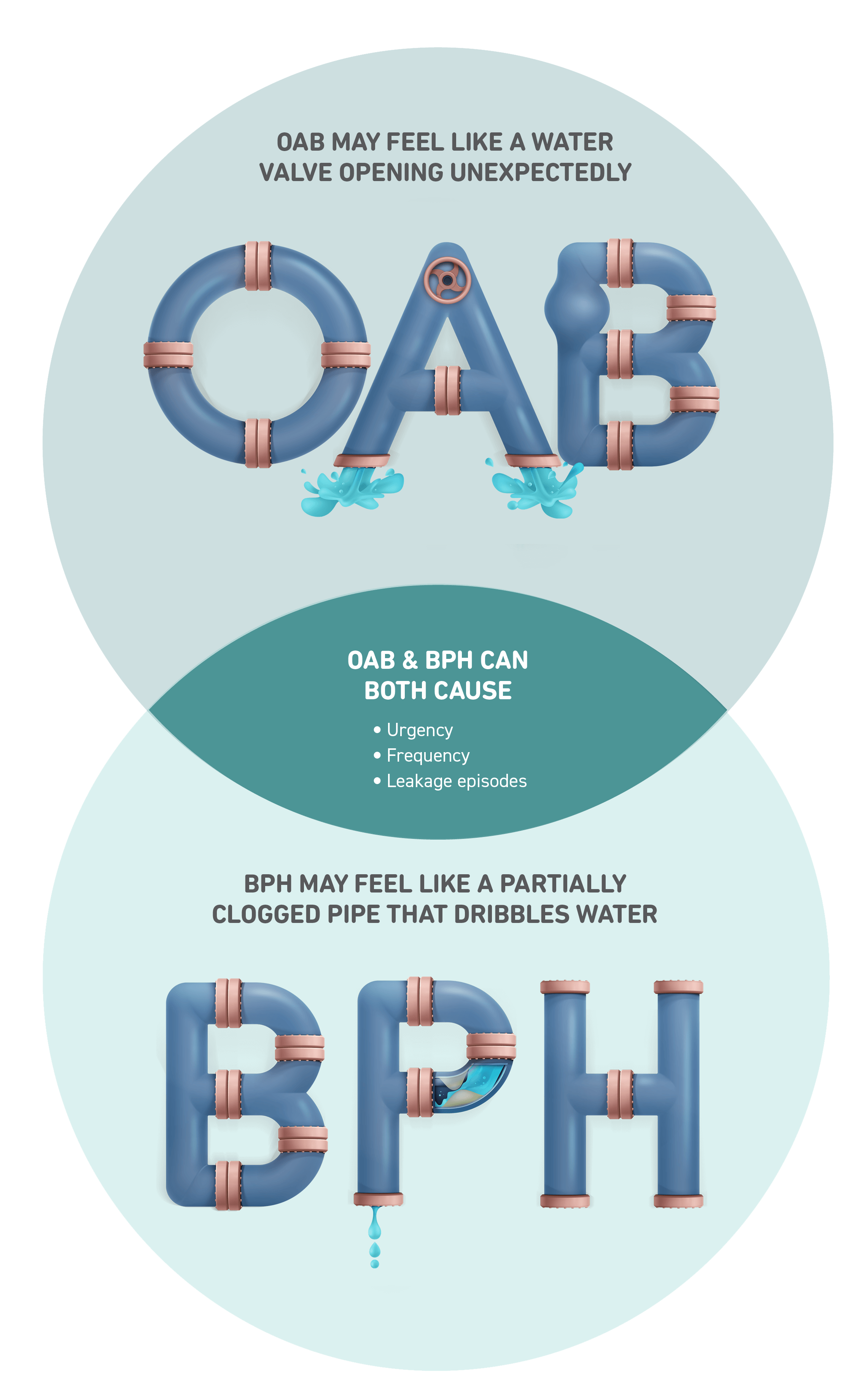
In OAB, nerve signals are telling the bladder to empty even when it isn’t full — resulting in that “can’t hold it in” feeling.
In BPH, the enlarged prostate is pushing on the urethra, causing that “have to pee but can’t get it out” feeling — resulting in just a dribble.
Transcript
ANIMATION: Time To Go and GEMTESA Logo + Super
ON-SCREEN SUPER: Rodney’s Go-Getter Journey
ON-SCREEN SUPER: [DISCLAIMER] Rodney is a real patient taking GEMTESA (vibegron) who has been compensated for his participation.
[RODNEY]: There were small ways in which OAB disrupted my life. I do a radio show for 3 hours every single day. And, in those three hours, I would have to go to the bathroom probably about 10 times. It really hurt my focus because all I could think about was “let’s get to break so I can go to the bathroom.” Going to sporting events was very difficult, which we like to do as a family. But when we go, often times, I will miss a full inning, or I’ll miss a big play, because I’m waiting in line for the bathroom. I was in a little bit of a denial. I wanted to hide it. I would tell stories like “I’m going to get some popcorn.” or “I’m going to get a drink at the concession stand,” or “I just gotta make a phone call.” and I’d really be running to the bathroom.
ON-SCREEN SUPER: [DISCLAIMER] Rodney Peete and his wife, Holly Robinson Peete.
Holly is a real patient taking GEMTESA (vibegron) who has been compensated for her participation.
[RODNEY]: My wife came to me. We were at a game and she said “Honey, this is the fifth time you went to the bathroom.” And, as much as I was in denial, I couldn’t argue with that. And I knew I had to get this checked out. Being an athlete sometimes you’re just taught to get over it or play hurt. Or, just, forget about the pain, forget about the symptoms, just go do it. And I lived my life that way for such a long, long time that I thought everything was normal. And, in the end, it wasn’t normal. It wasn’t a normal part of aging and I needed to get some help. Holly recognizing that in me, led me to the right decision. Sometimes as a male— your ego gets in the way. Having an overactive bladder is not something that you just want to throw out there in conversations, but it’s a real part of life. And, even around my friends, my male friends, it would be jokes about it. You know, we would actually have bets on who went to the bathroom the most at a football game. At the same time, it is something serious that you need to deal with. And, as my situation progressed, I felt more comfortable talking about it with my male friends. I was diagnosed with BPH—benign prostatic hyperplasia. And even with the treatment for BPH, I still had OAB symptoms of urgency, frequency, and leakage episodes. My doctor recommended GEMTESA which is proven to treat those OAB symptoms in men being treated for BPH. When I finally went to the doctor and got my diagnosis of OAB, I actually was relieved.
ON-SCREEN SUPER: Individual results may vary.
ON-SCREEN SUPER: GEMTESA Logo (will stay on for the remainder of the video).
[RODNEY]: When my doctor prescribed GEMTESA to me, I knew how it had helped Holly, and I was just praying that I would get those same results.
[VOICEOVER]: GEMTESA is a prescription medicine used to treat the following symptoms due to a condition called overactive bladder (OAB).
In adults, and in adult males taking medicine for benign prostatic hyperplasia (BPH): leakage episodes, urgency and frequency.
ON-SCREEN SUPER: GEMTESA is a prescription medicine used to treat the following symptoms due to a condition called overactive bladder (OAB).
In adults, and in adult males taking medicine for benign prostatic hyperplasia (BPH): leakage episodes, urgency and frequency.
[VOICEOVER]: Do not take GEMTESA if you are allergic to vibegron or any of the ingredients in GEMTESA.
Stop using GEMTESA and get emergency medical help right away if you have symptoms of angioedema or trouble breathing.
ON-SCREEN SUPER: Do not take GEMTESA if you are allergic to vibegron or any of the ingredients in GEMTESA.
Stop using GEMTESA and get emergency medical help right away if you have symptoms of angioedema or trouble breathing.
[VOICEOVER]: GEMTESA may cause serious side effects including inability to empty your bladder and/or angiodema. Stop using GEMTESA and get emergency medical help right away if you have symptoms of angioedema or trouble breathing.
Stop using GEMTESA and get emergency medical help right away if you have symptoms of angioedema or trouble breathing.
ON-SCREEN SUPER: GEMTESA may cause serious side effects including inability to empty your bladder and/or angiodema. Stop using GEMTESA and get emergency medical help right away if you have symptoms of angioedema or trouble breathing.
Stop using GEMTESA and get emergency medical help right away if you have symptoms of angioedema or trouble breathing.
[VOICEOVER]: The most common side effects of GEMTESA include headache, urinary tract infection, nasal congestion, sore throat or runny nose, diarrhea, nausea and upper respiratory tract infection. These are not all the possible side effects of GEMTESA.
ON-SCREEN SUPER: The most common side effects of GEMTESA include headache, urinary tract infection, nasal congestion, sore throat or runny nose, diarrhea, nausea and upper respiratory tract infection.
These are not all the possible side effects of GEMTESA.
[RODNEY]: Being on GEMTESA has allowed me to be more present in my life. I mean if we’re at a ball game, I’m thinking less about going to the bathroom, and focused on what’s happening in the game because my symptoms are being managed. Watching Holly the last 3 years while she’s gone on her journey with GEMTESA—I was very encouraged. And it gave me the courage to start my own journey.
After years of denial I was able to put that aside and get my act together. I’m so proud that I went to the doctor and took this step because I am putting myself first. And I’m very excited about it.
ON-SCREEN SUPER: One honest conversation can make all the difference. It’s Time to Go and Put Yourself First.
Talk to your doctor about overactive bladder symptoms and see if GEMTESA is right for you.
ANIMATION: Time To Go and GEMTESA Logo + Super
[NARRATOR VOICE-OVER]
What is GEMTESA?
GEMTESA is a prescription medicine used to treat the following symptoms due to a condition called overactive bladder in adults, and in adult males taking medicine for benign prostatic hyperplasia (BPH):
- urge urinary incontinence: a strong need to urinate with leaking or wetting accidents
- urgency: the need to urinate right away
- frequency: urinating often
It is not known if GEMTESA is safe and effective in children.
IMPORTANT SAFETY INFORMATION
Do not take GEMTESA (vibegron) if you are allergic to vibegron or any of the ingredients in GEMTESA.
Before you take GEMTESA, tell your doctor about all your medical conditions, including if you have liver problems; have kidney problems; have trouble emptying your bladder or you have a weak urine stream; take medicines that contain digoxin; are pregnant or plan to become pregnant (it is not known if GEMTESA will harm your unborn baby; talk to your doctor if you are pregnant or plan to become pregnant); are breastfeeding or plan to breastfeed (it is not known if GEMTESA passes into your breast milk; talk to your doctor about the best way to feed your baby if you take GEMTESA).
Tell your doctor about all the medicines you take, including prescription and over-the-counter medicines, vitamins, and herbal supplements. Know the medicines you take. Keep a list of them to show your doctor and pharmacist when you get a new medicine.
What are the possible side effects of GEMTESA?
GEMTESA may cause serious side effects including:
- inability to empty your bladder (urinary retention). GEMTESA may increase your chances of not being able to empty your bladder, especially if you have bladder outlet obstruction or take other medicines for treatment of overactive bladder. Tell your doctor right away if you are unable to empty your bladder.
- angioedema. GEMTESA may cause an allergic reaction with swelling of the lips, face, tongue, or throat, with or without difficulty breathing and may be life-threatening. Stop using GEMTESA and get emergency medical help right away if you have symptoms of angioedema or trouble breathing.
The most common side effects of GEMTESA include headache, urinary tract infection, nasal congestion, sore throat or runny nose, diarrhea, nausea and upper respiratory tract infection. These are not all the possible side effects of GEMTESA. For more information, ask your doctor or pharmacist.
Call your doctor for medical advice about side effects. You may report side effects to FDA at 1-800-FDA-1088.
Please see full Product Information at www.GEMTESA.com/PI.
Rodney Peete tackled the stigma and opened up about OAB with his wife and doctor
Transcript
ANIMATION: Time To Go and GEMTESA Logo + Super
ON-SCREEN SUPER: Rodney’s Go-Getter Journey
ON-SCREEN SUPER: [DISCLAIMER] Rodney is a real patient taking GEMTESA (vibegron) who has been compensated for his participation.
[RODNEY]: There were small ways in which OAB disrupted my life. I do a radio show for 3 hours every single day. And, in those three hours, I would have to go to the bathroom probably about 10 times. It really hurt my focus because all I could think about was “let’s get to break so I can go to the bathroom.” Going to sporting events was very difficult, which we like to do as a family. But when we go, often times, I will miss a full inning, or I’ll miss a big play, because I’m waiting in line for the bathroom. I was in a little bit of a denial. I wanted to hide it. I would tell stories like “I’m going to get some popcorn.” or “I’m going to get a drink at the concession stand,” or “I just gotta make a phone call.” and I’d really be running to the bathroom.
ON-SCREEN SUPER: [DISCLAIMER] Rodney Peete and his wife, Holly Robinson Peete.
Holly is a real patient taking GEMTESA (vibegron) who has been compensated for her participation.
[RODNEY]: My wife came to me. We were at a game and she said “Honey, this is the fifth time you went to the bathroom.” And, as much as I was in denial, I couldn’t argue with that. And I knew I had to get this checked out. Being an athlete sometimes you’re just taught to get over it or play hurt. Or, just, forget about the pain, forget about the symptoms, just go do it. And I lived my life that way for such a long, long time that I thought everything was normal. And, in the end, it wasn’t normal. It wasn’t a normal part of aging and I needed to get some help. Holly recognizing that in me, led me to the right decision. Sometimes as a male— your ego gets in the way. Having an overactive bladder is not something that you just want to throw out there in conversations, but it’s a real part of life. And, even around my friends, my male friends, it would be jokes about it. You know, we would actually have bets on who went to the bathroom the most at a football game. At the same time, it is something serious that you need to deal with. And, as my situation progressed, I felt more comfortable talking about it with my male friends. I was diagnosed with BPH—benign prostatic hyperplasia. And even with the treatment for BPH, I still had OAB symptoms of urgency, frequency, and leakage episodes. My doctor recommended GEMTESA which is proven to treat those OAB symptoms in men being treated for BPH. When I finally went to the doctor and got my diagnosis of OAB, I actually was relieved.
ON-SCREEN SUPER: Individual results may vary.
ON-SCREEN SUPER: GEMTESA Logo (will stay on for the remainder of the video).
[RODNEY]: When my doctor prescribed GEMTESA to me, I knew how it had helped Holly, and I was just praying that I would get those same results.
[VOICEOVER]: GEMTESA is a prescription medicine used to treat the following symptoms due to a condition called overactive bladder (OAB).
In adults, and in adult males taking medicine for benign prostatic hyperplasia (BPH): leakage episodes, urgency and frequency.
ON-SCREEN SUPER: GEMTESA is a prescription medicine used to treat the following symptoms due to a condition called overactive bladder (OAB).
In adults, and in adult males taking medicine for benign prostatic hyperplasia (BPH): leakage episodes, urgency and frequency.
[VOICEOVER]: Do not take GEMTESA if you are allergic to vibegron or any of the ingredients in GEMTESA.
Stop using GEMTESA and get emergency medical help right away if you have symptoms of angioedema or trouble breathing.
ON-SCREEN SUPER: Do not take GEMTESA if you are allergic to vibegron or any of the ingredients in GEMTESA.
Stop using GEMTESA and get emergency medical help right away if you have symptoms of angioedema or trouble breathing.
[VOICEOVER]: GEMTESA may cause serious side effects including inability to empty your bladder and/or angiodema. Stop using GEMTESA and get emergency medical help right away if you have symptoms of angioedema or trouble breathing.
Stop using GEMTESA and get emergency medical help right away if you have symptoms of angioedema or trouble breathing.
ON-SCREEN SUPER: GEMTESA may cause serious side effects including inability to empty your bladder and/or angiodema. Stop using GEMTESA and get emergency medical help right away if you have symptoms of angioedema or trouble breathing.
Stop using GEMTESA and get emergency medical help right away if you have symptoms of angioedema or trouble breathing.
[VOICEOVER]: The most common side effects of GEMTESA include headache, urinary tract infection, nasal congestion, sore throat or runny nose, diarrhea, nausea and upper respiratory tract infection. These are not all the possible side effects of GEMTESA.
ON-SCREEN SUPER: The most common side effects of GEMTESA include headache, urinary tract infection, nasal congestion, sore throat or runny nose, diarrhea, nausea and upper respiratory tract infection.
These are not all the possible side effects of GEMTESA.
[RODNEY]: Being on GEMTESA has allowed me to be more present in my life. I mean if we’re at a ball game, I’m thinking less about going to the bathroom, and focused on what’s happening in the game because my symptoms are being managed. Watching Holly the last 3 years while she’s gone on her journey with GEMTESA—I was very encouraged. And it gave me the courage to start my own journey.
After years of denial I was able to put that aside and get my act together. I’m so proud that I went to the doctor and took this step because I am putting myself first. And I’m very excited about it.
ON-SCREEN SUPER: One honest conversation can make all the difference. It’s Time to Go and Put Yourself First.
Talk to your doctor about overactive bladder symptoms and see if GEMTESA is right for you.
ANIMATION: Time To Go and GEMTESA Logo + Super
[NARRATOR VOICE-OVER]
What is GEMTESA?
GEMTESA is a prescription medicine used to treat the following symptoms due to a condition called overactive bladder in adults, and in adult males taking medicine for benign prostatic hyperplasia (BPH):
- urge urinary incontinence: a strong need to urinate with leaking or wetting accidents
- urgency: the need to urinate right away
- frequency: urinating often
It is not known if GEMTESA is safe and effective in children.
IMPORTANT SAFETY INFORMATION
Do not take GEMTESA (vibegron) if you are allergic to vibegron or any of the ingredients in GEMTESA.
Before you take GEMTESA, tell your doctor about all your medical conditions, including if you have liver problems; have kidney problems; have trouble emptying your bladder or you have a weak urine stream; take medicines that contain digoxin; are pregnant or plan to become pregnant (it is not known if GEMTESA will harm your unborn baby; talk to your doctor if you are pregnant or plan to become pregnant); are breastfeeding or plan to breastfeed (it is not known if GEMTESA passes into your breast milk; talk to your doctor about the best way to feed your baby if you take GEMTESA).
Tell your doctor about all the medicines you take, including prescription and over-the-counter medicines, vitamins, and herbal supplements. Know the medicines you take. Keep a list of them to show your doctor and pharmacist when you get a new medicine.
What are the possible side effects of GEMTESA?
GEMTESA may cause serious side effects including:
- inability to empty your bladder (urinary retention). GEMTESA may increase your chances of not being able to empty your bladder, especially if you have bladder outlet obstruction or take other medicines for treatment of overactive bladder. Tell your doctor right away if you are unable to empty your bladder.
- angioedema. GEMTESA may cause an allergic reaction with swelling of the lips, face, tongue, or throat, with or without difficulty breathing and may be life-threatening. Stop using GEMTESA and get emergency medical help right away if you have symptoms of angioedema or trouble breathing.
The most common side effects of GEMTESA include headache, urinary tract infection, nasal congestion, sore throat or runny nose, diarrhea, nausea and upper respiratory tract infection. These are not all the possible side effects of GEMTESA. For more information, ask your doctor or pharmacist.
Call your doctor for medical advice about side effects. You may report side effects to FDA at 1-800-FDA-1088.
Please see full Product Information at www.GEMTESA.com/PI.
These are just a few ways men may try to control their OAB before seeking treatment:
- Limiting liquids
- Wearing liners
- Diet changes — cutting out certain foods/beverages
- Planning trips around bathroom availability
- Mapping restrooms
- Emptying bladder multiple times in a short time frame
- Bringing extra clothes
- Carrying empty containers for times when they cannot find a bathroom quickly
Why cope longer than you may have to? There’s a treatment option that may help.
Treating BPH alone may not be enough
If you’re already treating BPH and you are still bothered by OAB symptoms, the problem may not be your prostate — it may be a bladder issue. Ask your doctor to screen for both OAB and BPH, as different medicines are used for each condition.
- BPH is usually treated with a prescription treatment called an “alpha blocker” or 5 alpha-reductase inhibitors — and sometimes surgery
- OAB is usually treated with either:
- Beta3-agonists (β3-agonists), which work to lessen OAB symptoms by helping the bladder muscle relax so it can hold more urine, or
- Anticholinergics (AChs), which work to lessen OAB symptoms by helping to stop involuntary bladder contractions (when the bladder squeezes itself without your control)
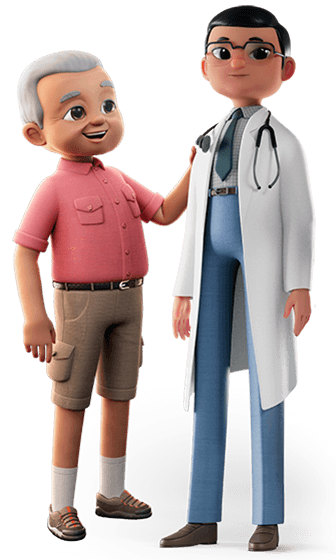
If you’re on BPH medicine but are still feeling symptoms such as urgency — a sudden urge to go — it may be time to ask your doctor about an OAB treatment option.
See How OAB Treatment May Help